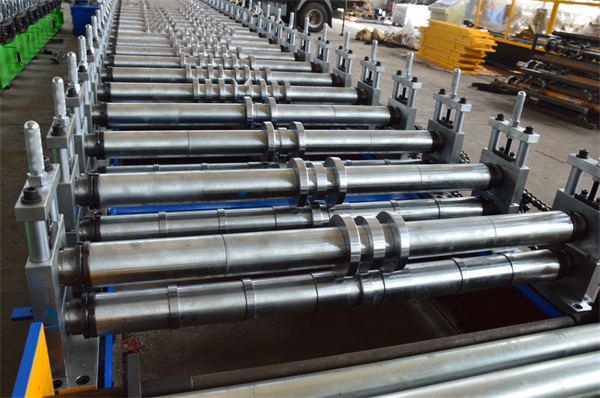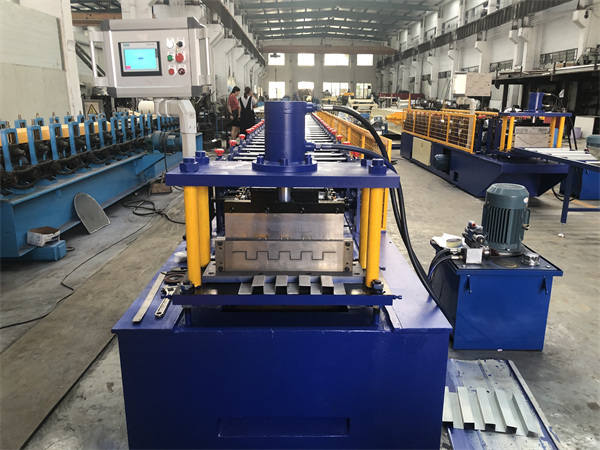When it comes to roofing materials, metal has gained significant popularity for its durability, versatility, and aesthetic appeal. Behind the sleek and functional metal roofs that adorn modern buildings lies a remarkable technology: metal roofing roll forming machines. These machines have transformed the roofing industry, offering a cost-effective and efficient way to produce high-quality metal roofing panels. In this article, we’ll explore the world of metal roofing roll forming machines, their benefits, types, components, operation, and more.
Understanding Metal Roofing Roll Forming Machines
Metal roofing roll forming machines are mechanical wonders that convert flat metal coils into complex roofing panels through a continuous process. The machine takes in coiled metal sheets, processes them through a series of roller dies, and produces uniform roofing panels of various profiles. This process ensures precision and consistency in the shape and dimensions of the panels.

Benefits of Metal Roofing Roll Forming Machines
Cost Efficiency
Traditional methods of manufacturing roofing panels often involve time-consuming manual labor. Metal roofing roll forming machines automate this process, significantly reducing labor costs. Additionally, their efficient production leads to minimal material wastage, further contributing to cost savings.
Customization Options
Metal roofing roll forming machines allow for a high degree of customization. Building owners and architects can choose from a wide range of profiles, lengths, and colors to match the design and style of the structure. This customization potential enhances the visual appeal of the building.
Speed and Efficiency
The automated nature of these machines ensures a rapid production pace. They can churn out roofing panels at a consistent speed, meeting project deadlines without compromising on quality. This efficiency is especially valuable in large-scale construction projects.
Types of Metal Roofing Roll Forming Machines
Metal roofing roll forming machines come in various types, each designed for specific panel profiles.
Single Panel Roll Formers
Single panel roll formers are designed to produce a single type of roofing panel profile. They are ideal for projects that require a uniform roofing style throughout.
Double Layer Roll Formers
Double layer roll formers have the capability to produce two different panel profiles. This versatility is advantageous for projects that demand variation in roofing design.
Corrugated Panel Roll Formers
Corrugated panels are known for their strength and distinctive look. Corrugated panel roll formers specialize in creating these unique panels that are commonly used in agricultural and industrial settings.
Key Components of a Metal Roofing Roll Forming Machine
Metal roofing roll forming machines consist of several key components working in harmony:
Uncoiler
The uncoiler holds the metal coil and gradually feeds it into the machine. This controlled feeding prevents material damage and ensures a smooth production process.
Feeding System
The feeding system transports the metal coil into the roll forming unit. It is designed to maintain proper alignment and tension for accurate panel formation.
Roll Forming Unit
This is the heart of the machine. It consists of a series of rollers and dies that progressively shape the metal into the desired panel profile. The number and arrangement of rollers determine the complexity of the profile.
Cutting System
Once the panel has been formed, the cutting system precisely cuts it to the desired length. Some machines incorporate flying cutting systems for uninterrupted production.
Control System
Modern metal roofing roll forming machines are equipped with advanced control systems. These systems allow operators to adjust settings, monitor production, and troubleshoot issues in real-time.

Factors to Consider When Choosing a Metal Roofing Roll Forming Machine
Selecting the right machine for your roofing production needs involves considering several factors:
Production Requirements
Evaluate the expected production volume. Choose a machine that can meet your output needs without overexerting the equipment.
Material Compatibility
Different machines are designed for specific types of metal, such as steel, aluminum, or copper. Ensure the machine is compatible with the material you intend to use.
Profile and Design Complexity
If your projects involve intricate panel profiles, opt for a machine that can handle the complexity without compromising on quality.
Budget and Investment
Metal roofing roll forming machines come in a range of prices. Set a budget that aligns with your business’s financial capabilities.
Maintenance and Care for Longevity
Proper maintenance is crucial to ensure the longevity and optimal performance of your machine. Regular inspections, lubrication, and addressing minor issues promptly can prevent costly breakdowns.
How to Operate a Metal Roofing Roll Forming Machine
Operating a roll forming machine requires proper training. Operators should be familiar with loading coils, adjusting settings, monitoring the production process, and performing basic maintenance tasks.
Safety Precautions When Using Roll Forming Machines
Safety should be a top priority when operating roll forming machines. Operators should wear appropriate protective gear, follow safety protocols, and be cautious around moving parts.
Future Trends in Metal Roofing Roll Forming
As technology advances, metal roofing roll forming machines are likely to become even more efficient, with enhanced automation, user-friendly interfaces, and eco-friendly features.

Conclusion
Metal roofing roll forming machines have revolutionized the roofing industry by offering an efficient, cost-effective, and customizable solution for producing high-quality roofing panels. Their ability to streamline production while maintaining design flexibility makes them an invaluable asset in modern construction.
FAQs
- Are metal roofing roll forming machines suitable for small-scale projects?Yes, there are machines available that cater to smaller production volumes, making them suitable for various project scales.
- Can these machines work with different types of metals?Absolutely. Metal roofing roll forming machines can be adjusted to work with various metal types such as steel, aluminum, and copper.
- What kind of maintenance do these machines require?Regular maintenance involves cleaning, lubrication, and checking for any wear and tear. It’s essential for ensuring optimal performance.
- Do I need specialized training to operate these machines?Yes, proper training is necessary to operate metal roofing roll forming machines safely and effectively.
